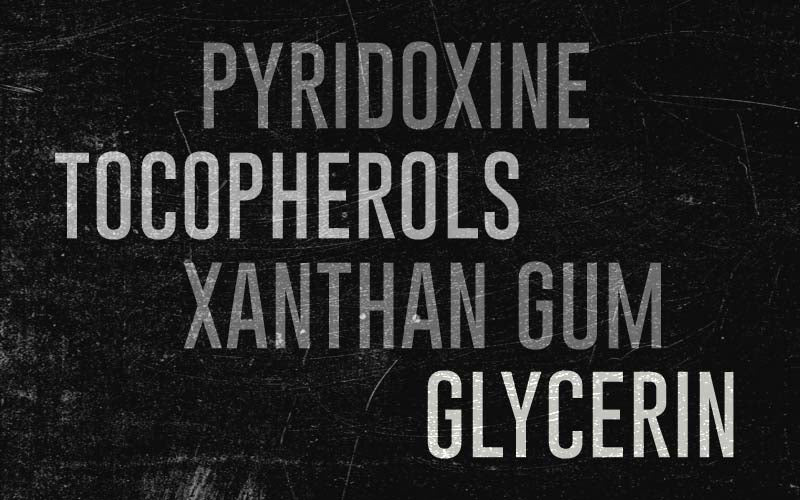FREE 🇺🇸 GROUND SHIPPING Orders 75+
FREE 🇺🇸 GROUND SHIPPING Orders 75+
Add description, images, menus and links to your mega menu
A column with no settings can be used as a spacer
Link to your collections, sales and even external links
Add up to five columns
Add description, images, menus and links to your mega menu
A column with no settings can be used as a spacer
Link to your collections, sales and even external links
Add up to five columns
Scary or Good?
October 25, 2022

By Kelly Reinhardt
Looking at ingredients, it’s sometimes hard to tell what is harmless, or even beneficial, and what is truly scary. Many of us see long, hard-to-pronounce ingredients and are immediately spooked. If you’re conscious of what goes in and on your body, you’ve likely looked at a label and thought “Hmmm, not sure I want that chemical in my life.” But in reality, everything is made up of chemicals – they’re the LEGO® bricks of our universe. So how do we know what’s safe and what we should avoid?
Well, in a word, “research.” But we all know that there’s a lot of misinformation out there on the internet, so it’s important to look at reputable sources. The Center for Science in the Public Interest has a great resource here for quickly checking out the safety of food additives, with 5 ratings ranging from “Safe” to “Avoid.” The World Health Organization has a searchable database of food additives here. The Environmental Working Group lets you easily search personal care products and ingredients here, and you can find more detailed info on all kinds of cosmetic and personal care ingredients at www.cosmeticsinfo.org. And as I always say, when in doubt, check Wikipedia!
Some scary-sounding but perfectly safe ingredients are pretty well known; Sodium Bicarbonate is simply baking soda – it makes your cake rise, and your teeth white when you brush with it. Acetic Acid is just vinegar – preserving both my favorite hot sauce and some locally made pickles I just picked up at the farmers’ market. (And if you combine the two, you’ll have yourself a science fair volcano!) No worries there.
But what about some less-familiar ingredients? What are they, where did they come from, what is their purpose, and are they safe?
Let’s start with glycerin, since that’s what started me on this research kick. I’m familiar with it since it’s in many of the soaps and body care products I’ve found to be gentle enough for my sensitive, allergy prone skin. So, I’ve generally regarded glycerin as safe. But when I recently found it in some high quality, three-ingredient dog treats, I thought “now what the..?!” I’d initially figured these dog treats must be pretty good. They’re made in the USA and contain only humanely-raised duck breast, glycerin, and salt. But that second ingredient gave me pause. “Isn’t that what’s in my soap?”
Turns out, glycerin (sometimes also listed as glycerine, glycerol, or glycyl alcohol) is indeed safe, in both food and body care products, as well as in pharmaceuticals – and it’s even sometimes used as a burn treatment. The US Food and Drug Administration lists it as GRAS (Generally Accepted as Safe), and the WHO deems it safe as well. (Learn about how the FDA’s GRAS regulatory process works here.) Glycerin is a type of carbohydrate called a sugar alcohol, or polyol. It’s formed naturally during some kinds of fermentation. However, most of the glycerin we’ll see in ingredient lists is produced commercially by breaking down plant or animal fats and oils, in a process called hydrolysis. (So, if you’re a vegetarian or vegan, you’ll want to look for vegetable glycerin specifically.) It’s used in food to add sweetness and “mouthfeel,” as well as to retain moisture, and as a preservative. The moisture retaining properties apply to body care products as well, since it can help soften your skin, and to both pull in and hold moisture.
So in those dog treats I mentioned, the glycerin preserves and retains moisture. In this Meliora Stain Stick, it helps to hold the stain-fighting ingredients together and keeps it pliable. And in this HiBAR Face Wash Bar, it helps your skin stay soft and hydrated. Glycerin is officially on the “what’s good” list!
This sent me on a tear through the house to find other ingredients that need digging into. I now have a long list to research, so let’s start with just a few.
On the scale of “I know exactly what that is” to “that sounds super scary,” Pyridoxine Hydrochloride had my needle in the red. But I found it in the ingredient list on my jar of nutritional yeast, right before Cyanocobalamin — and I know what that one is. Sounds like a nasty chemical cocktail, but as a long-time vegetarian, I need a B12 supplement, and that is just the simple name for Cyanocobalamin. (There are other forms, but that’s the most common.) So how bad could this Pyridoxine Hydrochloride really be? Maybe it too is the formal chemical name for another vitamin? Turns out, that’s exactly right — it’s just B6. Phew! It was at this point that realized I might be just spooking myself with these weird, halfway-unpronounceable ingredients. But better safe than sorry, eh? Let the research continue.
What else is lurking in my pantry, my shower, my fridge, and my bathroom?
Yet another ingredient that I found in both food and body care products is Xanthan Gum. I spied it in salad dressing, hot sauce, almond milk, and these UnPaste Tooth Tabs. So what the heck is this stuff?
Xanthan Gum is a polysaccharide (a type of carbohydrate) produced from simple sugars during a fermentation process using the bacteria Xanthomonas campestris, which lends the product its name. It was deemed safe by the US FDA in 1968, and continues to be considered safe as a food additive and personal care product ingredient by the US, Canada, the EU, and many other countries, as well as by the WHO, citing a study as recent as 2016. So what is it for? Basically, it increases the viscosity (thickness or stickiness) of liquids. It helps prevent oil separation in dressings, improves the texture in commercially produced ice creams, thickens hot sauces, and acts as a binder to keep those UnPaste Tooth Tabs held together. Xanthan Gum gets the “What’s Good®” seal of approval!
The next ingredient in the “you sound scary, why are you in my bathroom AND refrigerator?!” list is none other than…*drumroll*…Tocopherols! I found it in salad dressing (again?! No wonder I usually make my own.), and in my deodorant. On one hand, I suppose I’m happy that ingredients being used in my body care products are food safe – it implies a level of overall safeness, I guess – but on the other hand…it just seems weird to eat things that are in my deodorant. But maybe that’s because my deodorant is so. Dang. Natural! This SmartyPits deodorant (Lavender Bergamot or Grapefruit Cardamom, I can’t decide) is nice enough to tell us, in parentheses, that Tocopherol is Vitamin E. Gotta love products that help de-mystify, right? But what actually are Tocopherols, where do they come from, and what are they for?
Tocopherols are naturally occurring antioxidants – meaning they stop or slow down oxidation chain reactions by removing free radicals. (More on that in a moment.) You may see them listed as α-, β-, γ-, and ẟ-tocopherol, depending on their source; the plural “tocopherols” means more than one type is included in the mix. They can be found naturally in various foods such as oils, beans, nuts, seeds, eggs and milk. Commercially, as an additive, they are produced by vacuum steam distillation of vegetable oils. (This is the same process by which many types of essential oils are produced.) The WHO, FDA and the European Food Safety Authority all list tocopherols as safe, and the EWG considers it safe as an ingredient in personal care products. Additionally, the Expert Panel for Cosmetic Ingredient Safety, an independent, nonprofit scientific body in the US, found tocopherols to be safe in cosmetics.
But why is this in my salad dressing, deodorant, and this Weslee Rose Facial Serum? To slow oxidation, and therefore aging. Simply put, oxidation is when oxygen comes in and chemically changes things, very often not for the better. That half of an avocado that turned brown in less than an hour? That’s oxidation. The olive oil you’ve had way too long that now smells rancid? Oxidation. Even aging in humans is caused in part by oxidation. Antioxidants to the rescue! So those tocopherols help preserve the color and flavor of food. In body care products they also act as a preservative. Tocopherol, or Vitamin E, as an ingredient in skin care products is also known to have moisturizing properties – in part because the oil your skin itself produces naturally contains Vitamin E. The jury is still out on whether topical application prevents visible skin aging – it’s more important to consume Vitamin E in your diet with things like almonds, olives, avocados, and mangoes, to name a few. But we do know it can soften your skin and help it retain moisture. So, Tocopherols join the “officially not scary” list!
About the author:
Kelly's super power is that she is both a creative and an analyst. With degrees in studio art and english, she's a talented freelance writer and artist. At the same time, she's spent much of her career as an analyst and enterprise resources planning administrator — you might say she's as comfortable with a paintbrush as she is geeking out on data mining. She's a life-long environmentalist and passionate about helping others navigate this complicated green journey. She lives in Austin, TX with her husband and rescue pittie. Connect with her on LinkedIn.
Notes:
https://foodinsight.org/a-food-ingredients-journey-to-your-dinner-table/
https://foodinsight.org/the-benefits-of-preservatives-in-our-food/
https://www.prevention.com/food-nutrition/healthy-eating/a20449448/chemicals-in-food/
https://www.livestrong.com/slideshow/13580758-harmless-food-additives/
https://www.cspinet.org/page/chemical-cuisine-ratings
https://www.cosmeticsinfo.org/
https://apps.who.int/food-additives-contaminants-jecfa-database/
https://en.wikipedia.org/wiki/Glycerol
https://foodinsight.org/what-is-glycerin/
https://www.chemicalassociates.com/glycerin-uses.html
https://en.wikipedia.org/wiki/Pyridoxine
https://en.wikipedia.org/wiki/Xanthan_gum
https://en.wikipedia.org/wiki/Tocopherol
https://bakerpedia.com/ingredients/tocopherols/
https://www.ewg.org/skindeep/ingredients/706564-TOCOPHEROL/
https://health.clevelandclinic.org/vitamin-e-for-skin-health/
https://www.healthline.com/nutrition/foods-high-in-vitamin-e - TOC_TITLE_HDR_2
Leave a comment

Good News
If any email is worthy of your inbox, it's this. Our goal is 1–2x per month. You'll get helpful & inspiring eco info, plus subscriber-only discounts.
Welcome to What's Good
Here's your $10 coupon
COPY THIS CODE TO USE IN CHECKOUT

